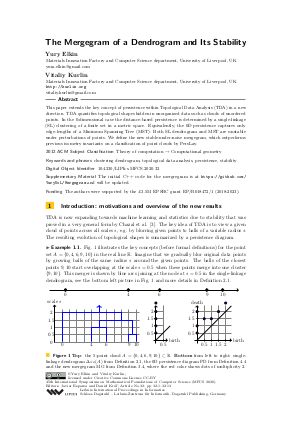The Mergegram of a Dendrogram and Its Stability
Authors Yury Elkin, Vitaliy Kurlin
-
Part of:
Volume:
45th International Symposium on Mathematical Foundations of Computer Science (MFCS 2020)
Part of: Series: Leibniz International Proceedings in Informatics (LIPIcs)
Part of: Conference: Mathematical Foundations of Computer Science (MFCS) - License:
 Creative Commons Attribution 3.0 Unported license
Creative Commons Attribution 3.0 Unported license
- Publication Date: 2020-08-18
File

PDF
LIPIcs.MFCS.2020.32.pdf
- Filesize: 0.58 MB
- 13 pages
Document Identifiers
Subject Classification
ACM Subject Classification
- Theory of computation → Computational geometry
Keywords
- clustering dendrogram
- topological data analysis
- persistence
- stability
Metrics
- Access Statistics
-
Total Accesses (updated on a weekly basis)
0PDF Downloads0Metadata Views
Abstract
This paper extends the key concept of persistence within Topological Data Analysis (TDA) in a new direction. TDA quantifies topological shapes hidden in unorganized data such as clouds of unordered points. In the 0-dimensional case the distance-based persistence is determined by a single-linkage (SL) clustering of a finite set in a metric space. Equivalently, the 0D persistence captures only edge-lengths of a Minimum Spanning Tree (MST). Both SL dendrogram and MST are unstable under perturbations of points. We define the new stable-under-noise mergegram, which outperforms previous isometry invariants on a classification of point clouds by PersLay.
Cite As Get BibTex
Yury Elkin and Vitaliy Kurlin. The Mergegram of a Dendrogram and Its Stability. In 45th International Symposium on Mathematical Foundations of Computer Science (MFCS 2020). Leibniz International Proceedings in Informatics (LIPIcs), Volume 170, pp. 32:1-32:13, Schloss Dagstuhl – Leibniz-Zentrum für Informatik (2020)
https://doi.org/10.4230/LIPIcs.MFCS.2020.32
BibTex
@InProceedings{elkin_et_al:LIPIcs.MFCS.2020.32,
author = {Elkin, Yury and Kurlin, Vitaliy},
title = {{The Mergegram of a Dendrogram and Its Stability}},
booktitle = {45th International Symposium on Mathematical Foundations of Computer Science (MFCS 2020)},
pages = {32:1--32:13},
series = {Leibniz International Proceedings in Informatics (LIPIcs)},
ISBN = {978-3-95977-159-7},
ISSN = {1868-8969},
year = {2020},
volume = {170},
editor = {Esparza, Javier and Kr\'{a}l', Daniel},
publisher = {Schloss Dagstuhl -- Leibniz-Zentrum f{\"u}r Informatik},
address = {Dagstuhl, Germany},
URL = {https://drops.dagstuhl.de/entities/document/10.4230/LIPIcs.MFCS.2020.32},
URN = {urn:nbn:de:0030-drops-127281},
doi = {10.4230/LIPIcs.MFCS.2020.32},
annote = {Keywords: clustering dendrogram, topological data analysis, persistence, stability}
}
Author Details
- Materials Innovation Factory and Computer Science department, University of Liverpool, UK
Funding
The authors were supported by the £3.5M EPSRC grant EP/R018472/1 (2018-2023).
Supplementary Materials
- The initial C++ code for the mergregram is at https://github.com/YuryUoL/Mergegram and will be updated.
References
-
Gunnar Carlsson and Facundo Memoli. Characterization, stability and convergence of hierarchical clustering methods. Journal of machine learning research, 11:1425-1470, 2010.

-
Mathieu Carriere, Frederic Chazal, Yuichi Ike, Theo Lacombe, Martin Royer, and Yuhei Umeda. Perslay: A neural network layer for persistence diagrams and new graph topological signatures. AISTATS, arXiv:1904.09378, 2020.

-
Frédéric Chazal, Vin De Silva, Marc Glisse, and Steve Oudot. The structure and stability of persistence modules. Springer, 2016.

-
David Cohen-Steiner, Herbert Edelsbrunner, and John Harer. Stability of persistence diagrams. Discrete & Computational Geometry, 37(1):103-120, 2007.

-
Sara Kalisnik, Vitaliy Kurlin, and Davorin Lesnik. A higher-dimensional homologically persistent skeleton. Adv. App. Maths, 102:113-142, 2019.

-
Vitaliy Kurlin. Auto-completion of contours in sketches, maps and sparse 2d images based on topological persistence. In Proceedings of SYNASC 2014 workshop CTIC: Computational Topology in Image Context, pages 594-601. IEEE, 2014.

-
Vitaliy Kurlin. A fast and robust algorithm to count topologically persistent holes in noisy clouds. In Proceedings of the IEEE Conference on Computer Vision and Pattern Recognition, pages 1458-1463, 2014.

-
Vitaliy Kurlin. A homologically persistent skeleton is a fast and robust descriptor of interest points in 2d images. In LNCS, Procedings of CAIP: Computer Analysis of Images and Patterns, volume 9256, pages 606-617, 2015.

-
William B March, Parikshit Ram, and Alexander G Gray. Fast euclidean minimum spanning tree: algorithm, analysis, and applications. In Proceedings of SIG KDD: Knowledge discovery and data mining, pages 603-612, 2010.

-
Manzil Zaheer, Satwik Kottur, Siamak Ravanbakhsh, Barnabas Poczos, Russ R Salakhutdinov, and Alexander J Smola. Deep sets. In Advances in neural information processing systems, pages 3391-3401, 2017.

